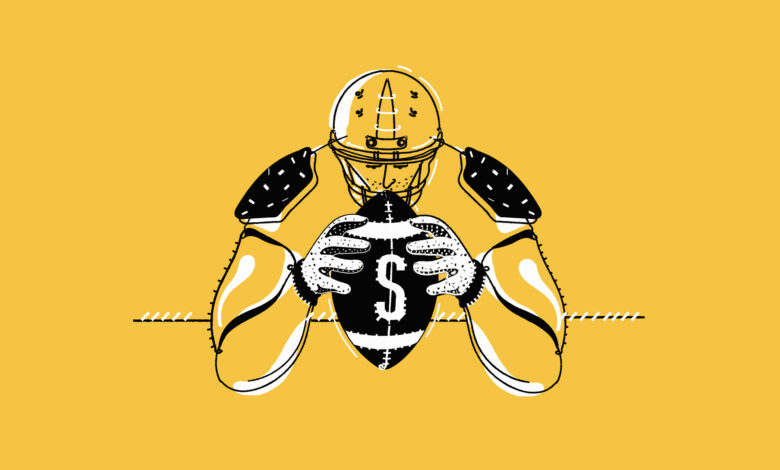Here are the cases for and against an $8 million Super Bowl ad

This story is part of Digiday’s annual coverage of the Super Bowl. More from the series →
HexClad, a direct-to-consumer cookware brand, is running its first Super Bowl spot this Sunday. The DTC brand is one of several new-comers, including Häagen-Dazs, Duracell and MSC Cruises, shelling out significant ad dollars to secure a 30- or 60-second spot in the Big Game.
It’s a risk, says Daniel Winer, co-founder and CEO of HexClad. “It’s frighteningly expensive, even for big companies,” said Winer, referring to the whopping $8 million price tag for a 30-second spot. “So you’re really left wondering, is the juice going to be worth the squeeze with this?”
Obviously, it’s a risk worth taking for HexClad, given the brand has a 30-second Big Game spot featuring Gordon Ramsay and Pete Davidson. For that kind of money, however, the stakes are high for advertisers to either come in for a perfect landing or risk wasting millions of ad dollars, which is par the course with the Super Bowl. But with the price tag up even more — let alone the cost of production and talent — it’s a gamble that some are sitting out.
Major automotive brands, for one example, that have run Big Game spots in the past, like Kia, BMW and General Motors, are no-shows this year leaving room for new entrants like HexClad. With newcomers taking a chance and staple brands sitting it out, it does beg the question: Who should advertise during the Big Game and why does it matter so much?
The case for a Super Bowl ad
123.4 million viewers
Perhaps the first point is the most obvious: A lot of people watch the Super Bowl, making it an opportunity for advertisers to get in front of hundreds of millions of viewers simultaneously – 123.4 million viewers to be exact. Those are figures from last year’s broadcast across CBS Television Network, Paramount+, Nickelodeon, Univision, CBS Sports and NFL digital properties, including NFL+, according to CBS Sports. This year’s game will air on Fox.
“If you have something to say, it’s the largest possible stage,” Nick Drabicky, svp and general manager of client services at January Digital marketing agency, wrote in an email to Digiday. He later added, “You’re buying eyeballs and attention, so this is the place to do it.”
In comparison, last year’s Grammy Awards drew 17.09 million viewers, according to The Hollywood Reporter. Those figures do not include streaming.
Last bastion of live sports
Increasingly, marketers have turned their attention to live sports, pouring money into the space as the perceived last bastion of live broadcast, monocultural moments. Meaning, the Super Bowl is one of the last places advertisers can get their marketing messages in front of everybody in one place at one time, which has always been the real value of the Super Bowl, marketers say.
“I would argue that the Super Bowl and the audience that it garners is probably more valuable than it’s ever been, and that’s due to the fragmentation of media,” said an agency executive who spoke on the condition of anonymity.
In the past, advertisers could stretch ad dollars across other prime-time broadcast television moments, (Remember ABC’s Thank God it’s Thursday broadcast lineup, anyone?), as opposed to the Big Game. Now, in an increasingly fragmented media landscape, those moments are few and far between, said the agency exec. “There’s more of a disparity between the Super Bowl audience vs. all the other audiences out there,” the exec said.
That’s not to say there’s no value in similar media moments, like the Academy Awards, the Grammys, World Series, NCAA Final Four and others. But the Super Bowl is still the big get, according to Michelle Spigner, strategy director at Mother LA.
“In a deeply fractured media landscape, it is rare for nearly half the nation to be gathered, seated and watching the same thing simultaneously,” said Spigner. “The Super Bowl audience is there and growing, and so marketers will pay for that attention.”
Fans want to see ads
In an era of skippable ads, the Super Bowl is one of the few places where some viewers are watching for the ads, flocking to social media to talk about both the Big Game plays and the ad spots in between them.
“This is the only time of year when people actually want to see and hear from brands,” said Danilo Boer, global creative partner at FCB, in an emailed statement. “The commercial is the culture, so my question is: why not be part of culture when culture wants you?” This year, FCB New York is behind ad spots for Pringles and Budweiser.
Case against Super Bowl ads
Rising costs
Each year, ad costs for the Super Bowl get more expensive. This year, spots are going from anywhere from $7 million, the original price tag, to $8 million, the figure quoted to last minute advertisers. Notably, that’s just the price of the spot itself, not including production, accompanying media buys, talent and more budget line items. (Here’s what else a $7M, 30-second Super Bowl budget can purchase in 2025.)
That dollar figure could serve as a hindrance to smaller brands or those that don’t have the financial means to shell out $8 million for a one-time spot.
Typically, advertisers that justify the high costs of a Super Bowl ad spot either have a product launch, movie premiere or some other message that needs a grand stage. Meaning, it’s only worth showing up to the Super Bowl with big news, said January Digital’s Drabicky. “This is not a good idea for small brands that don’t have the financial means: Better said, I would not mortgage the future of your brand on a single spot,” he added.
For example, this year Little Caesars pizza is back in the Super Bowl with an ad spot for its new Crazy Puffs product. Meanwhile, Avocados From Mexico, a regular Super Bowl advertiser, is sitting this year out, opting for a digital play as opposed to a traditional spot, according to Jasmine Dadlani, chief strategy officer at McKinney, the agency that works with both aforementioned brands. “Big news equals the Big Game,” she said.
Other options
Staying with Avocados from Mexico, instead of a traditional broadcast spot, the avocado brand is partnering with former NFL player Rob Gronkowski for a digital activation this year. Last year, Opendoor real estate company made a similar move, running a halftime spot in Atlanta’s local market, YouTube and Opendoor.com.
Increasingly, advertisers are looking for efficiencies within their media spend, taking a harder look at working dollars to ensure they’re getting the most return for those investments. In those cases, working around the Super Bowl to capitalize on the cultural moment, rather than shelling out the $8 million and some to officially be in it may be a more effective – and affordable – play.
In Opendoor’s case, the brand saw a lift in national awareness due to the organic attention and press coverage, according to David Corns, CMO at Opendoor. “For brands that require their message to last well beyond the Big Game, re-thinking the ‘traditional’ may be the best course of action,” he said.
Stiff competition
An estimated 50 brands are expected to advertise in this year’s Super Bowl, according to Forbes. Meaning, it could be stiff competition, especially for newcomers to the space. Sure, the Super Bowl is “where brands go to make noise in a way they can’t in any other space,” said Mother LA’s Spigner. At the same time, any brand advertising in this year’s Big Game will be joined by others with the same pattern of thinking, making the Super Bowl more saturated perhaps than other media opportunities, per the previous quoted anonymous agency exec.
“So much attention is given to a lot of high profile creative,” per the exec. “There’s a lot of distractions in the Super Bowl.”
All said, a spot in the Super bowl is a big bet. For some, the risk is worth the reward. For others, the millions expected to pay for a Super Bowl ad spot could be better spent elsewhere.
“Despite the promise of the Super Bowl’s grand stage, the decision to run a spot isn’t easy,” said Spigner, adding that the decision comes down to three questions: Will the impact justify the price tag? Does the brand message require mass attention? Finally, is the idea good enough to become a watercooler moment?
Come Super Bowl Sunday, advertisers showing up in this year’s Big Game will get their answers.



